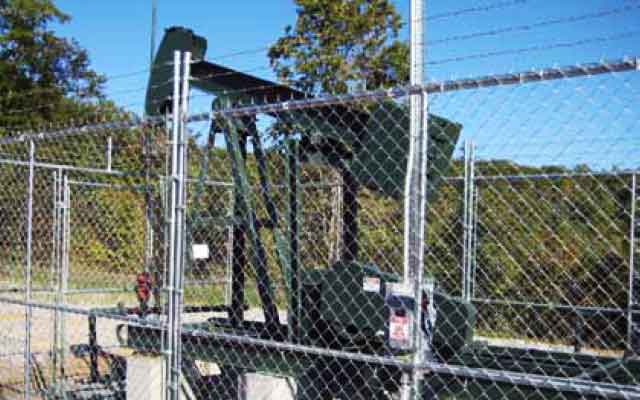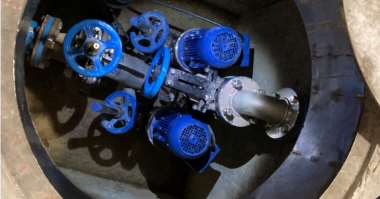Just like people, natural gas wells have their own unique and individual characteristics. Even within the same gas field, some wells are super-producers, while others consistently produce a low volume of gas. And similar to people, the wells change on a daily basis depending on environmental factors. In a way, the well is a natural, living thing, and utilizing a one-size-fits-all method to natural gas production won’t yield the best results.
A customized approach was the premise for an automated pump jack solution created by ATFAB, a system integrator and machine design company in Fall Branch, Tennesee. ATFAB was approached by an eastern United States natural gas production company looking for an automated solution for its dewatering application that would help them gain efficiencies in extraction, service, and maintenance, while also giving them the ability to monitor and control the sites remotely.
In natural gas production, dewatering is the removal of built-up water from solid material in a gas-producing well. A well is between 1,500 and 2,000 feet deep and when it intersects with a water table, a pump jack is needed to move water off the ground so the gas can move out. The more water, the more difficult it is for the gas to escape. At the same time, pumping the well completely dry damages the equipment. Therefore, there’s a fine balance between pumping the water out so it’s at as low a level as possible, without actually pumping the well dry.
Prior to an automated solution, the gas company utilized a timer box and a contactor. The well was either “on” or “off” for a predetermined amount of time that an operator manually set.
Algorithms and smart PLC enable condition-based pump jack
Working together with Schneider Electric™, The Global Specialist in Energy Management™ that offers integrated solutions across multiple market segments, ATFAB developed an automated pump jack solution with the Twido™ programmable logic controller (PLC), Altivar™ 312 variable frequency drive (VFD), and Magelis™ XBT N400 and XBT-GT500 human machine interface (HMI).
ATFAB and Schneider Electric worked with the natural gas producer for several years to develop a software program that accomplished everything the customer was hoping for. The result was a pump jack solution that calculates how long it should run based on site conditions, that shuts itself down when needed, rather than run for a set amount of time.
ATFAB discovered that the pump on/off cycle was not always optimal and the time required for pumping the water would vary based on current conditions. “Some wells showed more than a 50% energy savings from not having to run them in a time mode,” said Jeff Thornburg, ATFAB Operations Manager. “We also engineered the solution to allow the pump jacks to operate using three-phase motors instead of a single-phase mode, which garnered additional energy savings and maintenance costs by eliminating the capacitive start.”
 The best part is that an algorithm in the PLC allows the pump jack to learn from itself, and to make adjustments according to the unique characteristics of the well that it is controlling. After every cycle, the PLC examines how the pump jack ran and recalculates how long it will stay off and the length of running time for the next cycle based on current conditions.
The best part is that an algorithm in the PLC allows the pump jack to learn from itself, and to make adjustments according to the unique characteristics of the well that it is controlling. After every cycle, the PLC examines how the pump jack ran and recalculates how long it will stay off and the length of running time for the next cycle based on current conditions.
“Through this process, we learned that the wells change how much water is produced, even on a daily basis depending on the water table and other factors,” said Thornburg. “The new program allows it to adapt for every cycle based on the current conditions. As the PLC sees conditions changing, it automatically corrects itself.”
 Thornburg’s partner, Jim Ward, ATFAB Engineering Manager, confirms that ATFAB’s success in this application is due in large part because they recognized that each well had its own characteristics, and that those characteristics change daily. “We were successful because we didn’t treat all the wells the same. They’re all individual and different, and they’re always changing,” Ward said. “Essentially, each well has its own customized solution.”
Thornburg’s partner, Jim Ward, ATFAB Engineering Manager, confirms that ATFAB’s success in this application is due in large part because they recognized that each well had its own characteristics, and that those characteristics change daily. “We were successful because we didn’t treat all the wells the same. They’re all individual and different, and they’re always changing,” Ward said. “Essentially, each well has its own customized solution.”
Even in extreme cases, the automated pump jack solution knows what to do. For example, if there’s a power outage, the system will do a rewrite so the pump knows that it needs to pump all the water out of the column before it can resume optimal production of gas. With the time-based system, the pump jack would just pump off the water at the top of the well, not actually getting the water level low enough to allow gas to escape.
ATFAB wrote another algorithm that tells operators the position of the pump jack in the well while it’s running. This allows an operator to evaluate every stroke and know whether the pump jack is pumping water or nothing.
ATFAB accomplished the condition-based run time and positioning components of the solution without adding sensors or any other hardware to the well head. While most companies use sensors on the pump jack head itself, this is an expensive and prohibitive practice since it’s a Class 1, Division 1 hazardous location, requiring special equipment to avoid hazardous situations.
“In both instances we opted to write algorithms rather than run additional wires or equipment,” said Thornburg.
Automatic pump-off function
ATFAB recently completed the newest software iteration for this application which incorporates an automatic pump-off function. The well will automatically cease pumping when the controller sees that the well is running out of water. When the well is run dry, it burns the seals on the pump jack. While the seals themselves are only a few dollars, their replacement requires the entire pump jack to be pulled out of the well — this is not only expensive, but costs a great deal in lost production.
“We expect the addition of the pump-off feature in the software to be a significant cost savings opportunity for this gas producer,” said Ward.
Remote access simplifies field maintenance, connectivity enabled by two-byte addressing
One of the natural gas production company’s other requirements for a solution was remote monitoring and access to each well site via radio network. With one well tender responsible for 80 wells, all in remote areas, it was especially difficult to effectively manage them. Before the automated solution, the well tender’s only option was to jump in a truck and drive out to the site.
What made the remote monitoring aspect of the solution more challenging though, was the number of devices that needed to be on the network — including the VFD, modem, flow valve, flow computer, PLC, etc. — combined with the high number of wells.
 The automated solution uses the Modbus open communication protocol which transmits information serially between electronic devices. In a standard Modbus network there is one “parent” and up to 247 “child”, each one with a unique address. This limits the number of devices on the network to 247, which had severely limited the number of wells on each radio network.
The automated solution uses the Modbus open communication protocol which transmits information serially between electronic devices. In a standard Modbus network there is one “parent” and up to 247 “child”, each one with a unique address. This limits the number of devices on the network to 247, which had severely limited the number of wells on each radio network.
To move beyond this limitation, Schneider Electric was able to modify the firmware in the PLC to accommodate two-byte Modbus addressing, which extends the number of “child” in the network to 65,535. “Two-byte addressing has been key to getting the automation on the customer’s network so they can monitor the wells in real time,” said Ward. “Before, a well tender needed to go to the well with an HMI to diagnose the status or a problem. They wouldn’t even know if something was broken unless they happened to check. Now, this information is available on the network and anyone from anywhere can see the status and make control changes.” Added Thornburg, “The two-byte addressing was not Schneider Electric’s standard, but they were willing to modify it and meet the needs of the customer.”
The remote access also helps the customer monitor the water level in their 210 BBL tank that stores the pumped off water. Prior to the automated solution, the customer would send someone to check the tank every few days. Now they save time by checking the status remotely. Ultimately, the automated pump jack solution has been a huge success for the customer — achieving significant energy savings, a more efficient extraction process, and remote access that allows for proficient service and maintenance.
To learn more about pump solutions, visit www.schneider-electric.com. To learn more about ATFAB, visit their site at www.atfab.org.





Comments